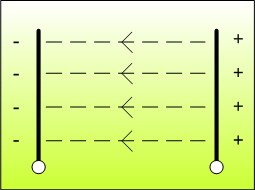Rasen-Sensoren: Unterschied zwischen den Versionen
(Die Seite wurde neu angelegt: „== Rasensensor == caption A lawn sensor should detect if the robot is still on lawn or not. In other words, it should find out if the m…“) |
(→Rasensensor) |
||
| Zeile 3: | Zeile 3: | ||
[[File:capacity.png|caption]] | [[File:capacity.png|caption]] | ||
| − | + | Ein Rasensensor soll feststellen, ob sich ein Rasenroboter noch über Rasen befindet oder nicht. Mit anderen Worten, er soll herausfinden, ob das Medium direkt unter dem Roboter noch Rasen ist oder irgend etwas anderes (z.B. Luft). Dazu kann ein kapazitiver Sensor benutzt werden, da das Medium unter dem Roboter die Kapazität beeinflusst. Es gibt jedoch keinen Unterschied zwischen einem Rasen und einem Blumenbeet z.B. Man sollte also einen Bereich um den Rasen herum haben, der sich deutlich von Rasen unterscheidet (z.B. Rindenmulch). | |
| − | + | ||
== Arbeitsprinzip == | == Arbeitsprinzip == | ||
Version vom 8. Juli 2015, 13:20 Uhr
Inhaltsverzeichnis
Rasensensor
Ein Rasensensor soll feststellen, ob sich ein Rasenroboter noch über Rasen befindet oder nicht. Mit anderen Worten, er soll herausfinden, ob das Medium direkt unter dem Roboter noch Rasen ist oder irgend etwas anderes (z.B. Luft). Dazu kann ein kapazitiver Sensor benutzt werden, da das Medium unter dem Roboter die Kapazität beeinflusst. Es gibt jedoch keinen Unterschied zwischen einem Rasen und einem Blumenbeet z.B. Man sollte also einen Bereich um den Rasen herum haben, der sich deutlich von Rasen unterscheidet (z.B. Rindenmulch).
Arbeitsprinzip
A lawn sensor could be a copper plate in a closed plastic tube. To find out if the plate has contact with lawn, the capacitance of this sensor is measured. If the robot is on lawn (lawn is 'dielectric'), the measured capacity increases slightly (by a few pF).
Wiring:
Front lawn sensor:
Arduino Mega Pin 40 Receive Front -------------|
Arduino Mega Pin 41 Send Front --- 2 MOhm --+---| Lawn
Back lawn sensor:
Arduino Mega Pin 42 Receive Back -------------|
Arduino Mega Pin 43 Send Back --- 2 MOhm --+---| Lawn
Detailed operation
Initially, the copper plate is discharged by pulling the send pin to low. Then the send pin is set to 'high' - via a resistor (2 Megaohm) the copper plate is charging slowly. By constantly reading input receiver pin, the Arduino measures the time until it becomes 'high' (capacity measurement). Because microcontrollers are fast and precise in time measurement, you can measure very low capacities with this.



